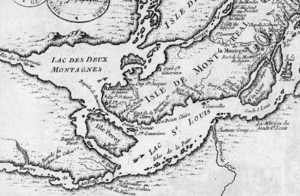Battle of The Cedars
| ||||||||||||||||||||||||||||||||||||||
The Battle of The Cedars (French: Les Cèdres) was a series of military confrontations early in the American Revolutionary War during the Continental Army's invasion of Quebec that had begun in September 1775. The skirmishes, which involved limited combat, occurred in May 1776 at and around The Cedars, 45 km (28 mi) west of Montreal, Quebec. Continental Army units were opposed by a small number of British troops leading a larger force of Indians (primarily Iroquois), and militia.
Brigadier General Benedict Arnold, commanding the American military garrison at Montreal, had placed a detachment of his troops at The Cedars in April 1776, after receiving rumors of British and Indian military preparations to the west of Montreal. The garrison surrendered on May 19 after a confrontation with a combined force of British and Indian troops led by Captain George Forster. American reinforcements on their way to The Cedars were also captured after a brief skirmish on May 20. All of the captives were eventually released after negotiations between Forster and Arnold, who was bringing a sizable force into the area. The terms of the agreement required the Americans to release an equal number of British prisoners. However, the deal was repudiated by Congress, and no British prisoners were freed.
Colonel Timothy Bedel and Lieutenant Isaac Butterfield, leaders of the American force at The Cedars, were court-martialed and cashiered from the Continental Army for their roles in the affair. After distinguishing himself as a volunteer, Bedel was given a new commission in 1777. News of the affair included greatly inflated reports of casualties, and often included graphic but false accounts of atrocities committed by the Iroquois that made up the majority of the British forces.
Background
The Cedars is located on the north shore of the Saint Lawrence River, about 45 kilometres (28 mi) from the center of modern Montreal, to the southwest of the western tip of the island of Montreal, from which it is separated by the Ottawa River. The nearby rapids in the Saint Lawrence required portage, making The Cedars a strategic landing point for anyone navigating the river to or from Montreal.[6] Crossing of the Ottawa River was made between Fort Anne and Quinze-Chênes,[7] now Vaudreuil.[8]
Montreal
In September 1775, early in the American Revolutionary War, a Continental Army under the direction first of Major General Philip Schuyler, and later of Brigadier General Richard Montgomery, invaded the British Province of Quebec. The city of Montreal was taken without a fight on November 13, following the Siege of Fort St. Jean. Montgomery left a garrison of troops under the command of Major General David Wooster in control of Montreal before leading the rest of the army to Quebec City. The occupation of Montreal was poorly managed, and relations between the Americans and the population, including those supportive of the Americans, deteriorated for a variety of reasons. One important factor that contributed to the poor relations was the American interdiction of trade with the Indian populations on the upper St. Lawrence and the Great Lakes, since the trade goods might be used to support British garrisons in those areas. The fur trade was economically important to the city, and its absence affected both supporters and opponents of the American cause.[9]
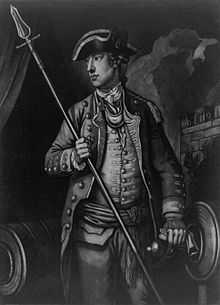
Following the American losses at the battle of Quebec at the end of 1775, Wooster eventually led reinforcements to Quebec. He arrived early in April 1776, and the military administration of Montreal passed temporarily to Colonel Moses Hazen before going to Brigadier General Benedict Arnold, who had been in command at Quebec. The American forces occupying the city numbered about 500, with additional forces at posts outside the city. Wooster had reported to General Schuyler as early as March 5 of rumored scheming between British troops and Indians to the west of the city.[10] In response to these alarming reports, as well as the unauthorized departures of two fur traders and Claude de Lorimier, a British Indian agent from Montreal, Hazen had sent 400 troops commanded by Colonel Timothy Bedel of Bedel's Regiment to occupy a strategic position at The Cedars in early April.[11] Lieutenant Isaac Butterfield led an advance force that arrived at The Cedars on April 26 and began construction of a wooden stockade fort, fortifying it with two four-pound cannons. Bedel and the rest of the detachment arrived on May 6.[12]
British call to arms
The Indian agent Lorimier traveled west to Oswegatchie, where a company of the 8th Regiment of Foot under the command of George Forster had occupied Fort de La Présentation.[13] Lorimier proposed recruiting a force of Indians to launch an attack on Continental forces at Montreal from the west. When Forster agreed, Lorimier went to Saint Regis, where he recruited 100 Mohawk men from Akwesasne.[14] Word of these activities led the American rebels to fortify The Cedars.[15]
At Fort Niagara in early May, Loyalist Captain John Butler held a conference with several hundred tribesmen, primarily from the Six Nations of the Iroquois, in which his goal was to break pledges of neutrality some of them had made in 1775. Butler, an experienced Indian agent, plied the natives with liquor and tales of combat; he convinced more than 50 Seneca, Cayuga, and Onondaga warriors to join the British cause, as well as some warriors from further west.[16] Historians are uncertain whether any of these recruits participated in the action at The Cedars, but it appears unlikely. Stanley (1973) is of the opinion that Indian participation was limited to those recruited by Lorimier, who went as far as Gananoque to recruit.[17] Lanctot (1967) and Smith do not identify any specific tribes participating in the action.[2][18][19]
James Stanley Goddard, one of the fur traders who left with Lorimier, traveled further west in an ultimately unsuccessful effort to raise an Indian force to oppose the Americans occupying Quebec. He reached Fort Michilimackinac in June, where the British commander, Captain Arent DePeyster, sent him recruiting among the Menominee and Winnebago tribes near Green Bay. DePeyster also sent out Joseph Ainsse, a local Indian interpreter, to recruit from tribes closer to the fort. None of the Indians recruited by these men reached Montreal until well after the Americans had left the city.[20]
Prelude
Once forces began assembling at Oswegatchie, Lorimier made arrangements with a sympathetic priest near The Cedars for the provisioning of supplies for the troops. With the assistance of some men of the 8th Foot, he strategically hid several shallow-draft boats, known as bateaux, near a point where the Saint Lawrence River could be crossed.[14]
Forster left Oswegatchie on May 12 with about 40 regular troops, 10 British and French-speaking Canadien militia, and 160 Iroquois. On May 14, they picked up 44 more Iroquois at Saint Francis, and camped at the western end of Saint Francis Lake on May 16.[21] On May 17, Forster received scouting reports about the troop strength at The Cedars. The Indians were concerned about the number of troops, but news that the Americans were in retreat from the city of Quebec emboldened them to act.[22]
On May 15, Colonel Bedel left The Cedars, leaving Lieutenant Butterfield in charge of the fort. Bedel later claimed that the reason for his departure was to meet with the friendly Caughnawaga Indians. In his court martial, the judges concluded this claim was suspect.[23] He returned to Montreal and reported that a force of 150 British troops of the 8th Foot and about 500 Iroquois commanded by Captain Forster was approaching. On this news, Colonel John Paterson sent Major Henry Sherburne with 140 men from his regiment toward The Cedars.[24] General Arnold, who was meeting with the retreating Continental Army command at Sorel at the time, returned to Montreal when the news reached him and set about organizing a larger relief force.[25]
Battle
The Cedars
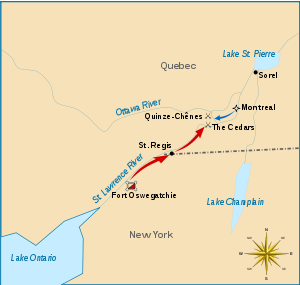
Forster's force landed near the American-occupied fort on May 18, and sent in a demand for surrender. Butterfield countered with a request to withdraw under arms, which Forster refused. The parties exchanged fire. During the course of the exchange, Forster received word that Sherburne had crossed the Ottawa River from the island of Montreal to Quinze-Chênes, but, believing The Cedars to have fallen already, had retreated back across the river. This news caused the besiegers to redouble their efforts the next day. Additional help arrived for the British in the form of about 40 Canadiens under Jean-Baptiste Testard de Montigny; Forster sent them to harass Sherburne. Word then came to Forster that Sherburne had resumed his advance; Butterfield, unaware of this, surrendered the fort.[22][26] The terms of capitulation included a guarantee of the personal safety of the captured men. The Iroquois plundered the fort's stores, and denied some of the captives small pouches of sometimes valuable personal items.[27]
Quinze-Chênes
Sherburne reached Fort Anne, across the Ottawa River from Quinze-Chênes, on May 17. A scout he sent across the river the next day was captured by Lorimier. The scout was allowed to notify Sherburne of his capture; in his message he included a claim that 500 Indians had surrounded the fort at The Cedars. Consequently, Sherburne decided to delay crossing the river, and sent word back to Montreal requesting further assistance.[8]
Sherburne decided to advance on May 20. Some of his men were apparently suffering from the aftereffects of smallpox, so these were left behind. Sherburne landed about 100 of his men at Quinze-Chênes, about 16 kilometres (10 mi) from The Cedars. When word of this crossing reached Forster, he ordered Lorimier to take 100 Indians and stop Sherburne. Lorimier was at first only able to immediately raise 40 warriors, but was joined on the way by another 40. Sherburne, not realizing that Butterfield had already surrendered, marched his troops right at Lorimier's advancing force. They fought for about 40 minutes before Sherburne, believing he was being attacked by a much larger force, surrendered.[27] The Iroquois claimed these captives as war spoils, since they were not part of the fort's garrison, and prepared to kill some of them in retaliation for their own losses. Only the intervention of Forster, who paid a ransom, prevented this; it did not prevent the Iroquois from stripping the prisoners of all but the clothes on their backs.[4]
Arnold's relief
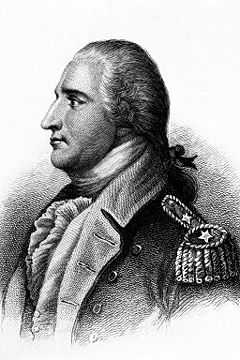
Following his successes, Forster moved his forces, including all of the prisoners, up to Quinze-Chênes, where more Loyalist militia had assembled. Leaving some of the prisoners there, he advanced on May 23 to Fort Senneville, a fortified works located on the southwest tip of Montreal island that was owned by Montigny.[4] In the meantime, General Arnold gathered most of the few remaining forces in Montreal, and sent requests to the outposts around the city for additional troops. By May 24, he was entrenched at Lachine, south of the city, and his force had reached 450 men. Forster began to advance on Lachine, but decided to retreat back to Quinze-Chênes when his scouts notified him of Arnold's position. He also received intelligence from Montreal that Arnold's force was going to be massively reinforced—the reported number of reinforcements was 1,500 to 2,000 men, more than Arnold had available in the area.[28][29]
Once his scouts reported Forster's retreat, Arnold gave chase. He reached Fort Senneville (which he burned) on May 26, just as Forster's men were landing on the far shore at Quinze-Chênes.[30][31] Arnold decided to send a group of Caughnawagas, who were friendly to the Americans, with a demand that Forster release his prisoners and a threat that he would destroy area Indian villages if any of the prisoners were harmed. Forster countered that he would permit his Indians to kill the prisoners if Arnold attacked.[31] Arnold attempted to cross the Ottawa River with a number of his men in bateaux, but Forster used the four-pounders captured at The Cedars to drive them back.[31]
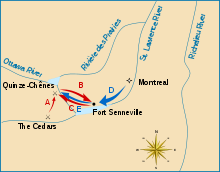
· A,B: British move to Fort Senneville, May 20–23
· C: British retreat, May 24–25
· D,E: American advance to Ottawa River crossing, May 26
Arnold called a war council so the Americans could consider their options. He wanted to mount a surprise attack the next morning; Hazen, who had acquired significant experience fighting Indians in the French and Indian War, argued against the idea. The disagreement between the two men was severe enough that it nearly provoked Arnold to file charges of insubordination against Hazen. The council decided not to act, voting Arnold's proposed attack down.[32] Early in the morning of May 27, a boat crossed the river carrying Major Sherburne and Forster's deputy, Lieutenant Parke. Forster, whose forces were somewhat reduced as some of the Indians had returned to their homes, had negotiated a prisoner exchange with Sherburne and Butterfield. After further negotiations, both Arnold and Forster agreed to terms. The American prisoners were returned to Arnold at Fort Anne on May 30, after being delayed for two days by high winds on the river.[33][34]
Aftermath
The Americans never held up their side of the prisoner exchange. Formally repudiating the agreement over the protests of George Washington, the Congress accused Forster of mistreating American prisoners by turning them over to the Indians. In a breach of etiquette, the letter containing the repudiation was delivered to Lieutenant General John Burgoyne, instead of the British commander-in-chief and governor of the province, Guy Carleton.[33] The Congressional action may have been tainted by overly lurid accounts of the action—Charles Carroll, part of a Congressional delegation that was in Montreal at the time, reported that "a hundred or more [American troops] were barbarously murdered by savages."[35] Arnold's report of the incident included otherwise unsubstantiated allegations that two prisoners were killed by Forster's Indians.[32] Some histories of the action (for example, the 1882 history by Jones) include accounts of significant atrocities committed by the Indians, but little supporting evidence has been found. The Congressional repudiation complicated an attempted prisoner exchange in 1781 involving Burgoyne and Henry Laurens, a Congressman from South Carolina whom the British were holding in the Tower of London; Laurens was eventually freed in exchange for a promise to help negotiate Lord Cornwallis's release.[36][37]
Arnold initially blamed Bedel for the defeat. He removed both Bedel and Butterfield from command and sent them to Sorel for court-martial. Due to the army's retreat, the two men were not tried until August 1, 1776 at Fort Ticonderoga. Both were convicted and cashiered from the army.[38] Bedel continued to volunteer his services, and following Burgoyne's surrender at Saratoga in October 1777, he was given a new commission by Congress.[39][40]
The site of some of the skirmishes was designated a National Historic Site of Canada in 1928.[41]
See also
Notes
- ↑ The conventional record of this battle, based mostly on American reports, is 500 Indians and 100 non-Indians (sometimes all characterized as British troops). Kingsford (1893), p. 59, lists these numbers, and, on preceding pages, describes in detail how they are justified.
- ↑ 2.0 2.1 2.2 2.3 Lanctot (1967), p. 141
- ↑ 3.0 3.1 None of the principal sources describing this action (Smith, Stanley, Kingsford, Lanctot) give any indication that anyone was killed or wounded in the action at The Cedars.
- ↑ 4.0 4.1 4.2 Kingsford (1893), p. 51
- ↑ Smith (1907), Vol 2, p. 373
- ↑ Smith (1907), Vol 2, p. 365
- ↑ Quinze-Chênes ("Fifteen oaks" in English) was the name of the place at the time. The place was later also known as Quinze Chiens ("fifteen dogs") or Vaudreuil.
- ↑ 8.0 8.1 Smith (1907), Vol 2, p. 372
- ↑ These events are recounted in great detail in e.g. Smith (1907), Vol 1, Lanctot (1967), and Stanley (1973).
- ↑ Wooster (1885), pp. 122–123
- ↑ Lanctot (1967), p. 141, establishes the date, but incorrectly assumes Arnold issued the order. Arnold was still at Quebec City (as was Wooster) on April 2. Arnold confirmed the order when he arrived in Montreal later in April (Smith Vol 2, p. 365).
- ↑ Smith (1907), Vol 2, p. 366
- ↑ Leighton (2000)
- ↑ 14.0 14.1 Kingsford (1893), pp. 63–64
- ↑ Smith (1907), Vol 2, p. 363
- ↑ Glatthaar (2007), pp. 112–113
- ↑ Stanley (1973), p. 119
- ↑ Smith (1907), Vol 2, p. 367
- ↑ Early histories of this action—e.g. Stone (1838) (p. 153) and Beers (1883) (p. 93)—claim that Joseph Brant was among the Indian leaders participating in this action. This assertion is largely based on the behavior of one of the warriors and Arnold's memoirs; Smith (Vol 2, p. 596) documents that Brant went to England in November 1775, and did not return to New York until June 1776. Barbara Graymont's recent biography of Brant (Graymont (2000)) does not mention the event at all.
- ↑ Barnett (2003), p. 27
- ↑ Kingsford (1893), p. 46
- ↑ 22.0 22.1 Kingsford (1893), pp. 47–48
- ↑ Smith (1907), Vol 2, p. 593
- ↑ Jones (1882), p. 55
- ↑ Martin (1997), p. 210
- ↑ Angus (1955), p. 195
- ↑ 27.0 27.1 Kingsford (1893), pp. 49–50
- ↑ Martin (1997), p. 211
- ↑ Kingsford (1893), p. 52
- ↑ Kingsford (1893), p. 54
- ↑ 31.0 31.1 31.2 Martin (1997), p. 212
- ↑ 32.0 32.1 Kingsford (1893), p. 55
- ↑ 33.0 33.1 Kingsford (1893), p. 56
- ↑ Martin (1997), p. 214
- ↑ Kingsford (1893), p. 60
- ↑ Cobbett (1814), pp. 860–862
- ↑ Brant (2007), pp. 182–185
- ↑ Jones (1882), pp. 56–57
- ↑ Smith (1907), Vol 2, p. 471
- ↑ Metcalf (1915), p. 499
- ↑ "Battle of the Cedars". Directory of Designations of National Historic Significance of Canada. Parks Canada. Retrieved 4 March 2012.
References
- Angus, Alexander David (1955). Old Quebec, in the days before our day (2nd ed.). Montreal: Louis Carrier. OCLC 1296490.
- Barnett, LeRoy; Rosentreter, Roger (2003). Michigan's Early Military Forces: A Roster and History of Troops Activated Prior to the American Civil War. Detroit: Wayne State University Press. ISBN 978-0-8143-3081-4. OCLC 50899172.
- Beers, J.H. (1883). The History of the County of Brant, Ontario. Toronto: Warner, Beers, & Co. OCLC 35790361.
- Brant, Irving (2007). James Madison the Nationalist 1780–1787. Indianapolis: Read Books. ISBN 978-1-4067-2221-5. OCLC 3390344.
- Cobbett, William; Wright, John; Hansard, Thomas Curson (1814). The Parliamentary History of England, from the Earliest Period to the Year 1803. Volume 22 (1781–1782). London: Longman, Hurst, Rees, Orme & Brown. OCLC 28837253.
- Glatthaar, Joseph T.; Martin, James Kirby Martin (2007). Forgotten Allies: The Oneida Indians and the American Revolution. New York: Macmillan. ISBN 978-0-8090-4600-3. OCLC 144227352.
- Graymont, Barbara (2000). "Biography of Joseph Brant". Dictionary of Canadian Biography Online. Archived from the original on 14 February 2009. Retrieved 2009-01-22.
- Jones, Charles Henry (1882). History of the Campaign for the Conquest of Canada in 1776: From the Death of Montgomery to the Retreat of the British Army Under Sir Guy Carleton. Philadelphia: Porter & Coates. OCLC 2110167.
- Kingsford, William (1893). The History of Canada, Volume 6. Toronto: Roswell & Hutchinson. OCLC 3676642. Of the sources included here, Kingsford provides a lengthy and somewhat detailed account of the British view of the action.
- Lanctot, Gustave (1967). Canada and the American Revolution 1774–1783. Cameron, Margaret M. [translator]. Cambridge, MA: Harvard University Press. OCLC 2468989.
- Leighton, Douglas (2000). "Biography of Claude-Nicolas-Guillaume de Lorimier". Dictionary of Canadian Biography Online. Retrieved 2009-01-21.
- Martin, James Kirby (1997). Benedict Arnold: Revolutionary War Hero. New York: New York University Press. ISBN 978-0-8147-5646-1. OCLC 48841329.
- Metcalf, Henry Harrison et al. (1915). The Granite State Monthly. Volume 47. Manchester, NH: Granite Monthly Co. OCLC 2447262.
- Smith, Justin H (1907). Our Struggle for the Fourteenth Colony, Volumes 1 and 2. New York: G.P. Putnam's Sons. OCLC 259236.
- Stanley, George (1973). Canada Invaded 1775–1776. Toronto: Hakkert. ISBN 978-0-88866-578-2. OCLC 4807930.
- Stone, William Leete (1838). Life of Joseph Brant-Thayendanegea. New York: Alexander V. Blake. OCLC 3182176.
- Wooster, David; Osborn, Elbert (1885). Genealogy of the Woosters in America. San Francisco: M. Weiss. OCLC 666535. (contains transcripts of General Wooster's letters while in command at Montreal)
| ||||||||||||||||||
